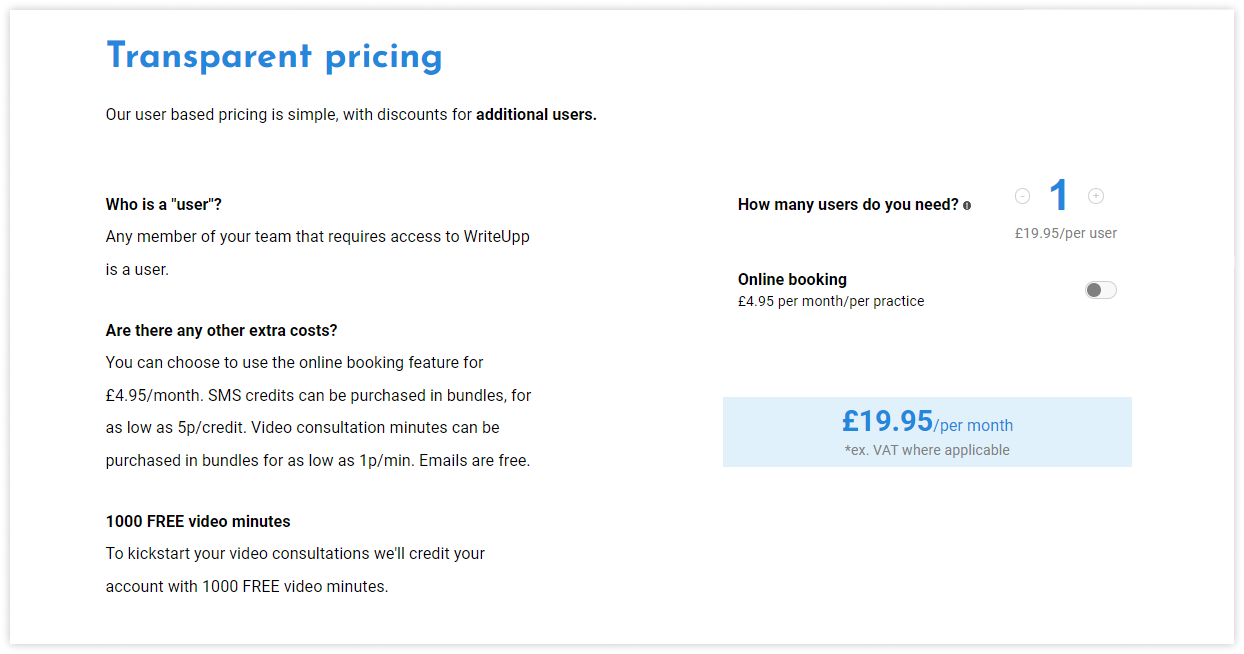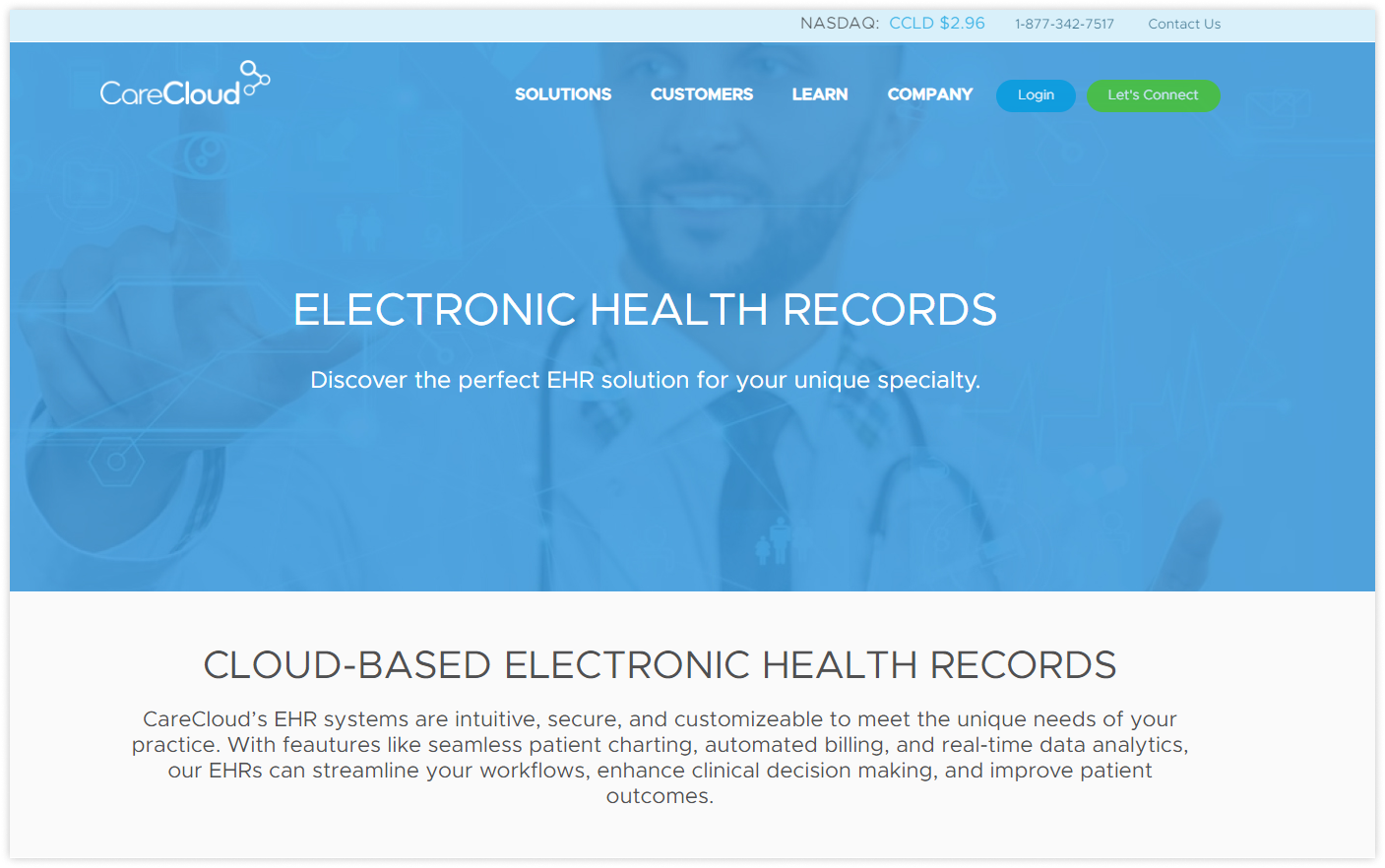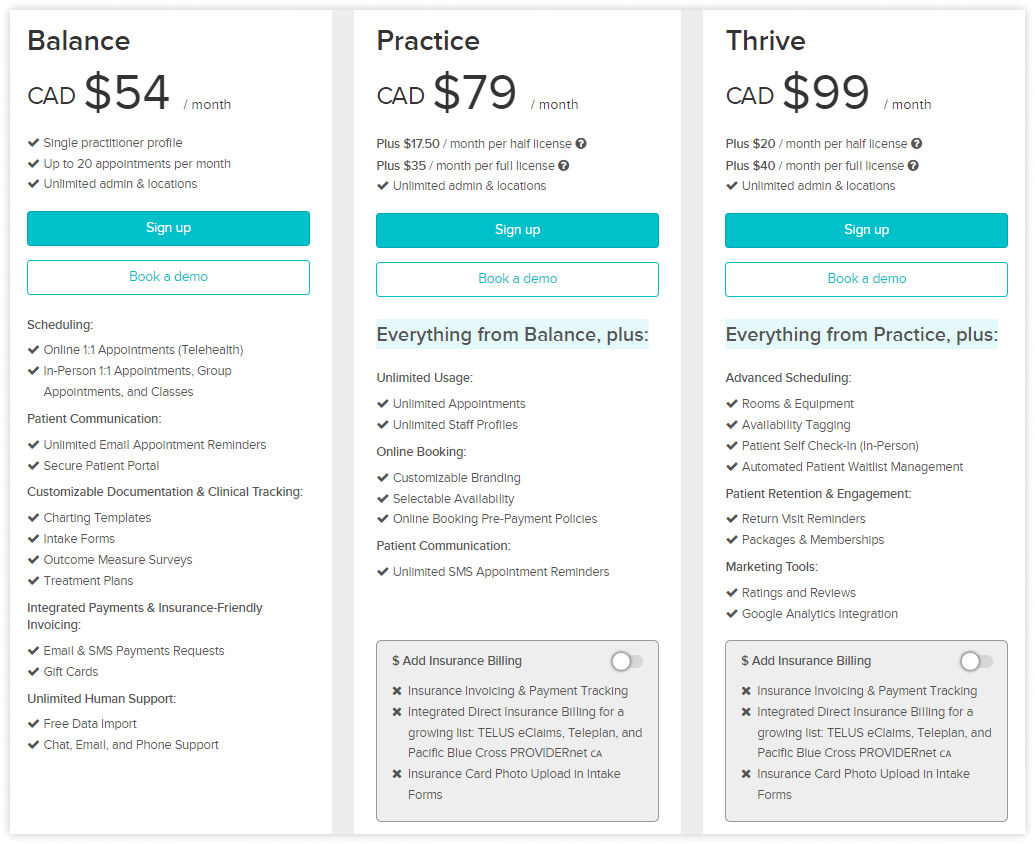With the transition to electronic document management and the abandonment of paper patient records, medical histories, and bills, the lives of doctors and clinic owners have changed markedly: two-thirds of IT leaders for healthcare systems reported that they are currently using cloud-based technology. People don't handwrite anymore.
The pandemic has driven them to the cloud, and it has also spurred strong growth in the cloud-based technology market. The United States EHR Cloud Computing Market is expected to register a CAGR of 11.58% over the forecast period from 2022 to 2027.
As a clinician or clinic owner, understanding what a cloud-based EHR system is and how it can benefit your practice is crucial for staying ahead in an increasingly digital world.
Learn how to simplify your practice workflow and free up more time for patients with Medesk.
Open the detailed description >>This article will explore the fundamentals of cloud-based EHR software and why they have become so widely used. We’ll also provide an overview of four popular EHR systems:
- Medesk
- WriteUpp
- CareCloud
- and Jane
What Is a Cloud-Based EHR System?
An electronic health record (or EMR) system is a digital version of a patient’s paper chart. It contains patient data, including medical history, diagnoses, medications, treatment plans, immunisation dates, and test results.
Traditionally, they were on-premises EHRs, requiring physical servers and IT infrastructure within the medical practice. However, with the advent of cloud computing, EHR solutions have migrated to the cloud, giving healthcare organizations more freedom to manage patient charts and records.
A cloud-based electronic health records system is hosted on remote servers and accessed over the internet. All information is securely stored in data centers managed by third-party EHR vendors. This setup allows clinicians and staff to access patient records from any device with internet connectivity, whether they are in the clinic, at home, or on the go.
How does a cloud-based EHR system work?
At its core, a cloud-based EHR system functions like any other web-based real-time service.
Authorised users can access the EHR system through a web browser or a dedicated application on their computers, tablets, or smartphones. Because the data is stored in the cloud, it can be accessed from any location, provided there is an internet connection.
Cloud-based EHR systems use advanced protocols to ensure data security during transmission and storage. This includes data encryption, multi-factor authentication (such as passkeys in healthcare), regular security audits, regulatory GDPR and HIPAA.
One of the major advantages of cloud-based systems is automatic data backup. The cloud provider regularly backs up data to prevent loss in the event of a system failure or disaster. This ensures that patient records are always recoverable and up-to-date.
Medesk helps automate scheduling and record-keeping, allowing you to recreate an individual approach to each patient, providing them with maximum attention.
Learn more >>Why does healthcare need the cloud-based solution?
Cloud computing brings many pros to solving the challenges in the healthcare industry.
1. Easy access to medical records
Previously, each patient stored their medical data in separate files, making record-keeping difficult for doctors and staff. Cloud computing has simplified this process. Now, electronic records can be stored in one central location. They can be accessed through medical centre web portals at any convenient time.
2. Improved quality of patient engagement
Patients can initiate virtual consultations or book a doctor's appointment with just a few mouse clicks. Automated reminders of upcoming appointments and follow-up become routine. Patients can easily share, view, and store their medical records in the cloud, and doctors can access and archive this information remotely.
3. Efficient use of resources
Cloud technologies can provide excellent support for managing staff, administrative and operational functions. They also provide scheduling, file retrieval, referral, and inventory management services, making processes more efficient, profitable, and cost-effective.
4. Flexibility in extreme situations
In extreme situations such as pandemics, natural disasters, or access issues, cloud services become extremely useful. In such situations, the availability of doctors and medical assistance is limited, and cloud systems allow information to be relayed to those on duty with instructions on how to treat the injured or ill.
5. Facilitating medical research and development
Doctors and medical staff invest efforts in research to improve their practice by collecting important data on surgeries and treatments. Storing and sharing this information in the cloud helps them analyse and research more efficiently and use it for case studies, making it available to other doctors and scientists.
6. Access to data analytics
In the field of analytics, where tasks require a deeper understanding of data, cloud-based tools become indispensable, and innovations from quantum computing companies are pushing the boundaries of data processing in healthcare. Healthcare has a vast amount of data, including patient information, both structured and unstructured. Cloud technologies enable the collection of relevant patient data from different sources. The application of big data analytics and artificial intelligence can drive medical research and develop more personalised treatment plans.
7. Patients' ownership of their data
Cloud computing centralises data and gives patients control over their information. This increases patient participation in making decisions about their health. Automated data backup and decentralised data storage make data recovery more efficient.
8. Interoperability and collaboration
Cloud systems allow doctors and healthcare providers to work together and improve patient outcomes. When all data is available in one place, a collaborative team is formed that includes stakeholders to develop plans, track progress, and provide consistent care to improve health outcomes. Medical records, diagnoses, and patient histories are instantly shared via the cloud with various medical professionals and information systems. In addition, collaboration with insurance companies can facilitate seamless payments.
9. Cost efficiency
Traditional EHR systems require substantial investment in hardware, servers, and IT staff. In contrast, cloud-based systems operate as SAAS arrangements, where clinics pay a monthly or annual fee based on usage.
10. Scalability
As your small practice grows, so do your EHR needs. Cloud-based systems can easily scale to accommodate more users, additional storage, and new features without requiring significant changes to your existing setup.
Disadvantages of Cloud-Based EHR Systems
We want to be completely honest, so we will mention the disadvantages of cloud medical systems.
First and foremost is internet dependency. Microsoft's worldwide outage on 19 July 2024 showed us how much we depend on the internet and software: any disruption in connectivity can hinder access to patient records. Clinics located in areas with unreliable internet service may experience difficulties, especially during outages.
Also, the subscription fees can add up over time, particularly for larger practices with many users. It's important to weigh these ongoing costs against the benefits.
Finally, clinics depend on the EHR software vendor for system maintenance, updates, and support.
Top 4 Cloud-Based EHR Systems in 2025
Now that we’ve covered the basics of cloud-based EHR systems, let’s take a closer look at four popular options: Medesk, WriteUpp, CareCloud, and Jane.
1. Medesk
Medesk is cloud-based practice management software that integrates with over 20 modules, including electronic medical records with forms, documents, invoices, and billing.

With Medesk, you get:
- EHR module that tracks your patients’ complete medical history, automates your prescriptions with the drug database from eMC, labels each diagnosis with ICD-10, and offers ready-made and customisable templates.

- An online booking tool that integrates with your website and social media platforms and helps you streamline the appointment scheduling process for your patients.
- Medical CRM to manage doctor-patient interactions, gather valuable feedback, and enhance your services.
- Medical billing tools automate the revenue cycle management and payment processes, saving time andminimisingg payer errors.
- Telemedicine capabilities to provide virtual consultations for patients who cannot attend in person.
- Reporting and analytics tools that allow you to quickly compile reports and monitor your clinic’s performance.
![[en] tag segment](https://www.medesk.net/q2vojxd7ywwe/72VxjZlENfVhhN0AHAxZ2N/57ace8f82d468696061adbad087365e4/patinet_tag_segment__1_.png)
We have outlined some system advantages based on user reviews. The first one is the pricing that saves your budgets thanks to an appointment-based subscription. It means you don’t pay for each user, but for the number of appointments.
Then, the system offers the exclusive acquisition channel analytics tool to monitor patient sources without extra costs. Geographic restrictions reduce verification costs and strengthen the security of your patient portal.
Medesk is also considering the integration of healthcare virtual assistants to optimise workflows and improve patient care.
Pricing
Medesk offers three subscription plans starting at $12 per 50 appointments per month. The Pro plan costs $18 per 100 appointments per month.

You can explore the platform’s features with a free trial of the Pro plan. Gain access to essential medical office tools, including appointment scheduling, patient data management, printable document templates, customisable consultation forms, digital medical records (EMR), task management, email appointment reminders, in-depth analysis of patient sources, and a dedicated mobile app.
Discover more about the essential features of Medesk and claim your free access today!
Explore now >>2. WriteUpp
WriteUpp EHR software streamlines your practice operations by bringing everything you need onto a single, secure, cloud-based platform.

Designed specifically for population health experts, physiotherapists, chiropractors, and other healthcare professionals, it empowers you to:
- Conduct secure video consultations with patients anytime, anywhere.
- Simplify note-taking with ready-made templates and efficiently manage patient records.
- Easily schedule appointments using a drag-and-drop interface and send automated reminders.
- Customise intake orms and templatesf to match your specific workflow and patient needs.

With the "Diary" feature, you can effortlessly manage your calendar, add new patients, set up recurring appointments, and seamlessly integrate invoices for smooth billing.
The "Client Records" section provides a clear, comprehensive view of each client, giving you access to vital information, health details, contact data, and any third-party involvement at a glance. Use the built-in filter options across all modules for quick and easy data organisation.
For effective internal communication within your clinic, take advantage of the internal messaging system. Additionally, during your 30-day trial, WriteUpp offers 1,000 free video minutes for remote consultations, allowing you to connect with patients virtually at no extra cost.
Pricing

Pricing is determined by the number of users. For a single user, the cost is £19.95 per month. If you wish to include the online booking module, it will be an additional £4.95 per month per practice.
Additionally, you have the option to purchase SMS credits in bundles (5p per credit) and video consultation minutes (1p per minute).
3. CareCloud
CareCloud is a HIPAA-compliant EHR and health information system that caters to larger practices and medical groups. It offers a wide range of features, including patient scheduling, billing, clinical documentation, and telemedicine integration.

CareCloud offers you several EHR options:
- CareCloud Charts
- talkEHR
- and VertexDR.
CareCloud Charts is designed to optimise the management of patient data, though some users may find navigating the system somewhat challenging and perhaps less intuitive than anticipated.
CareCloud maintains a list of recently viewed patient charts, making it easy to revisit and switch between charts from recent visits without difficulty.
The platform also allows for the simultaneous review of multiple charts through tabs located at the top of the screen. This feature is particularly useful for comparing recent charges with patient encounter notes, all while keeping the interface uncluttered.

talkEHR, another EHR provided by CareCloud, promises efficient electronic health record management. However, some users may struggle with its features and functionalities, finding the learning curve steep, especially for those unfamiliar with more complex software systems.
VertexDR is a comprehensive EMR solution tailored for anaesthesiology.
Users generally commend CareCloud for its comprehensive feature set, customisable workflows, and strong customer support. However, the higher cost can be a concern for smaller practices, and some users have noted a learning curve when initially implementing the system.
Pricing
CareCloud’s pricing is dependent on the services you select. For just the Practice Management System (CareCloud Central), the cost is $349 per provider per month. However, if you decide to include both the Electronic Medical Record system (CareCloud Charts) and the PMS, the price increases to $628 per provider per month.
4. Jane
Jane is a HIPAA-compliant practice management system tailored for therapists, naturopaths, and other healthcare professionals.
It’s accessible on mobile devices, making it a convenient tool for managing daily tasks.

Jane is an excellent choice for those who value personalization. You can customise its interface to suit your preferences, including voice commands in the charting, colour-coding, the main menu layout, and the online booking portal.

Jane’s charting feature simplifies the management of electronic health records and patient data. Secure video consultations allow up to 12 participants, enabling you to conduct online group sessions. Jane provides comprehensive reports and analytics, offering evaluations of patient scheduling, billing processes, and revenue cycle management through visually engaging dashboards.
Pricing

Jane offers three plans with additional charges for group telemedicine. Pricing plans start at CAD $54 per month per single clinician. Non-profit organisations can benefit from discounted rates.
In order to choose the EHR system that best suits your practice, we suggest you try the free trials of the products. Pay attention to the functionality, download speed, and user-friendliness of the interface.


